
Artists Devin N. Morris (left) and Khari Johnson Ricks, viewing works by Carybe, Jan Voss, Eikoh Hosoe, Marianetta Porter, Miller & Shellabarger, David Hammons, and Ren Hang. Photo by author unless otherwise indicated.
Since its founding in 1870, The Met library's mission has included serving as an educational resource for the public at large, not only for the Museum's staff and curators. Over the past 150 years, the library has assisted countless students, artists, and designers by providing inspiration and information that often directly influences their specific projects or general practice. On the occasion of The Met's 150th Anniversary, I'm pleased to share a look at how the library served artists and designers in its earliest decades and continues to do so today, by both highlighting ways in which artists discover and utilize Watson and profiling a few individual artists who have been engaging with Watson’s collection in recent years.
As early as 1907, official Met publications include reports of increasing numbers of artists and students visiting the library to "avail themselves of the opportunities offered for the study of works relating to the fine and industrial arts and archaeology." Met librarians at that time made concerted efforts to meet the needs of artists and designers for visual resources. In addition to books and journals "not readily available elsewhere," the library developed a study collection of photographs for "connoisseurs and collectors, artists, architects, and students" to consult. Between 1906 and 1910, over twenty-nine thousand photographs of art, architecture, antiquities, archaeological sites, and applied art objects were acquired directly from artists, museums, galleries, and other sources.
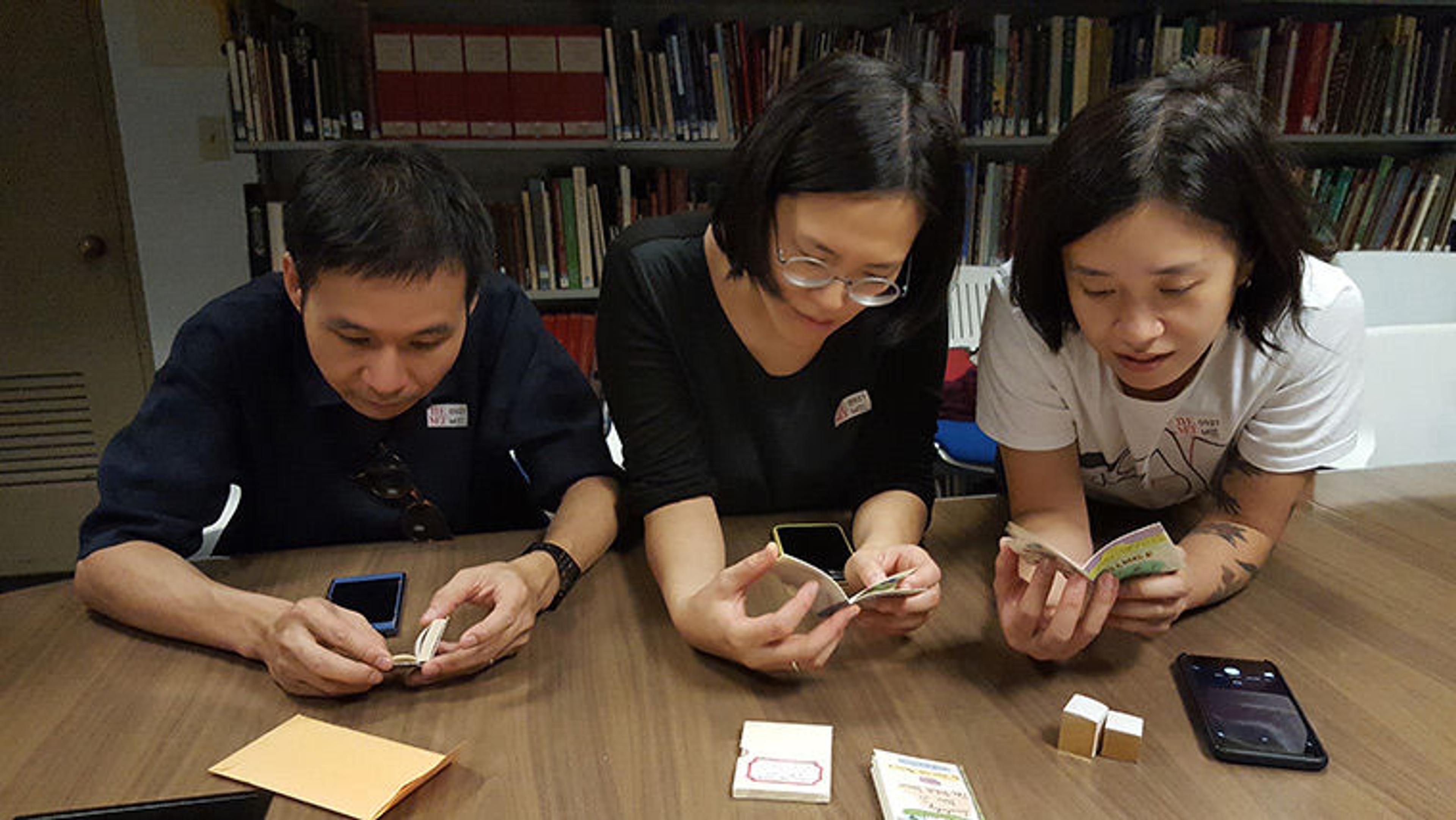
Left to right: artists Chihoi, Son Ni, and Hai-Hsin Huang, viewing Q.R.V. by Edward Gorey (Boston: Anne & David Bromer, 1989), and Three Small Books by Roz Chast (New York: Kathryn Markel, 1982)
Library Committee and Museum Trustee reports from the 1910s and 1920s describe extensive use of the library's holdings as primary source materials for classroom instruction and tracing. These early reports also document the acquisition of materials within specific subject areas to meet demand. For example, in 1917 and 1919 respectively, the library acquired books on poster design, supplemented by a collection of war and commercial poster examples, and a collection of photographs of war memorials and proposals for memorials, in support of a movement "to encourage the development of suitable war memorials."

Left: Samantha Dion Baker, illustrator, designer, and author of Draw Your Day (California: Watson-Guptill, 2018), viewing Album du peintre en batiment: travaux élémentaires, ornements, filage, composés et exécutés par N. Glaise; les bois et les marbres (Paris: Ducher, 1875-1884). Right: Samantha Dion Baker, sketch journal page, commemorating her visit to Watson. Detail of an Instagram post by @sdionbakerdesign, April 12, 2016
Reports from the years 1918 and 1919 recount extensive purchases on the subjects of ceramics, textiles, costume, jewelry, and furniture design. These reports illustrate the library's commitment to "providing material from which the designer might gain inspiration," as well as the library's support of the Museum's efforts "to encourage and stimulate designers of applied art…in various branches of industry." They also serve as a testament to the frequency at which designers visited the library, including those "from other cities engaged in the textile industries and in the manufacture of jewelry."

Artist Tia Blassingame viewing 71125, Fifty Years of Silence: Eva Kellner's Story, an artist's book by Tatana Kellner. You can find several of Tia's books in Watson Library's permanent collection.
A century later, artists and designers still comprise one of Watson's core constituencies. Watson librarians consistently provide instruction and orientations to undergraduate and graduate studio art, book art, and design students, classes from the New York Studio School, and artists in residence from the Textile Arts Center, among other groups.
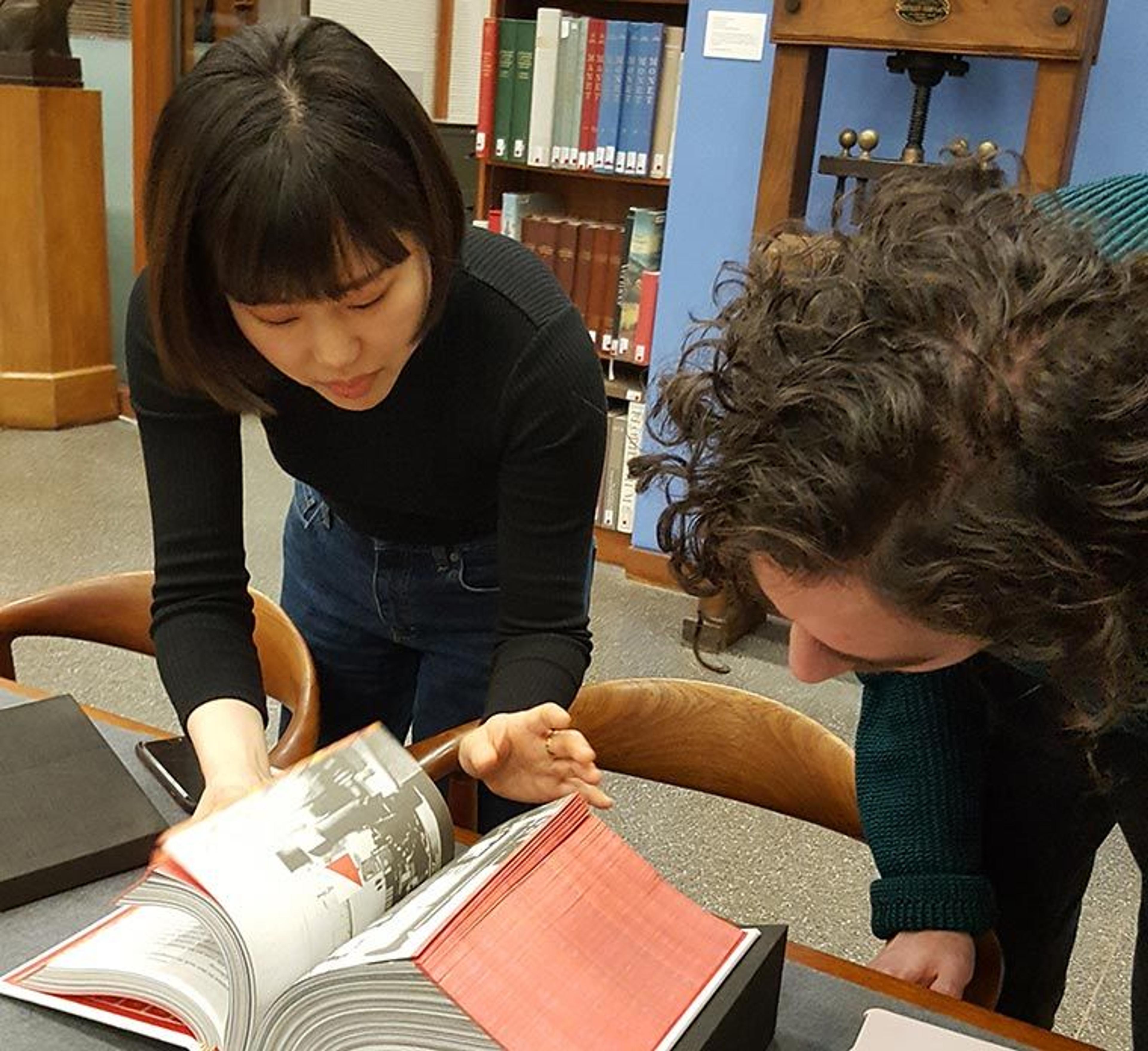
Gina Shin (left) and Frank Mondragon of the Met Design Department, with SHV Think Book (1996-1896), designed by Irma Boom and Johann Pijnappel (Utrecht: SHV Holdings, 1996)
Frequent guests to Watson include our colleagues from The Met's Design Department, artists in the Met Copyist program, and independent, unaffiliated artists and designers, many of whom have discovered Watson through word of mouth, postings on Instagram (@metlibrary / #metlibrary), or Pinterest. As Watson's special collections librarian, I routinely invite and encourage artists to visit, and relish the chance to select and share works with them from Watson's collection. Artists are also increasingly discovering Watson through library symposia, as well as library participation in Museum-wide events.
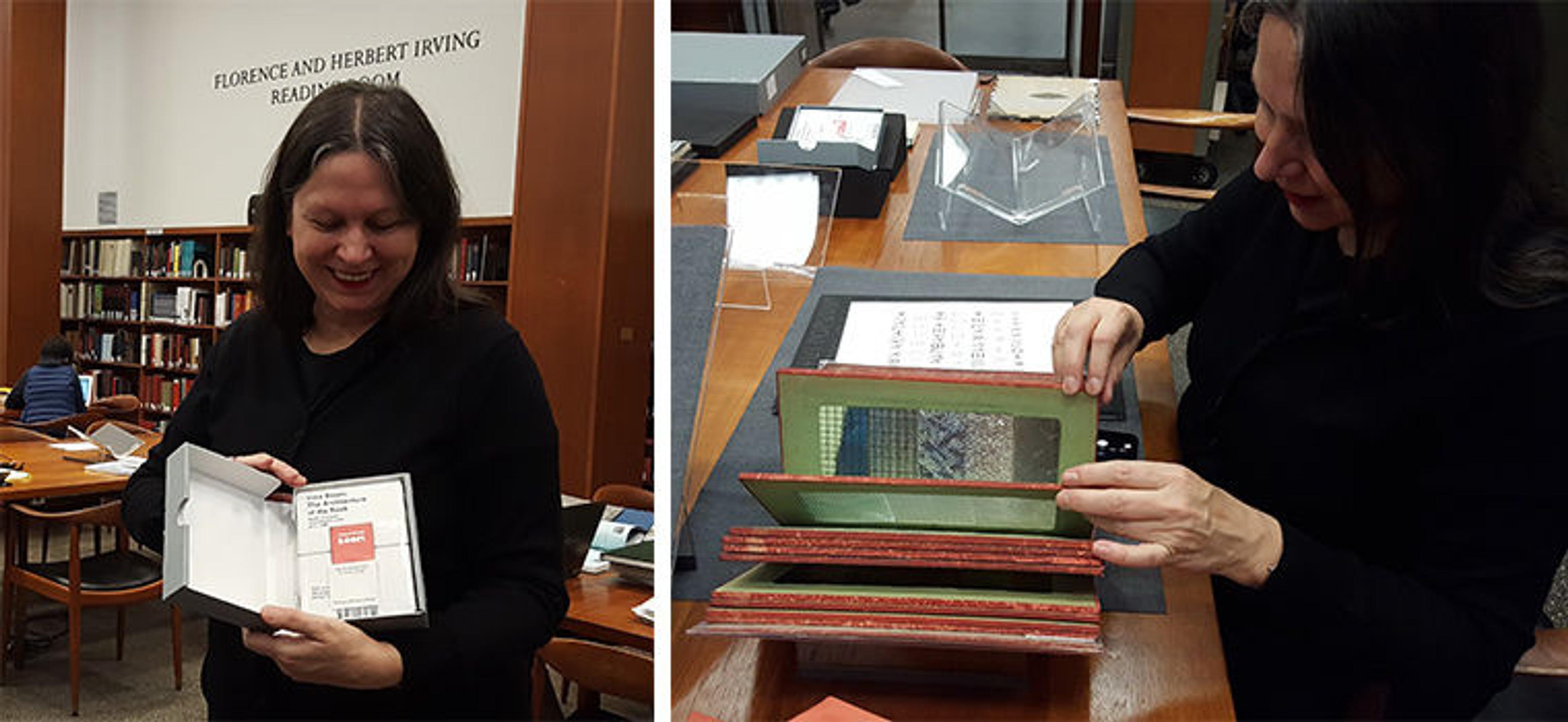
Graphic designer Irma Boom, "the Queen of Books," during a visit to Watson in 2017. An avid book collector, Boom viewed examples from Watson's collection of innovative and experimental book design, distinctive trade catalogs, and other collection highlights.
In 2016, in collaboration with The Met's Education Department, Watson teamed up with artist Tauba Auerbach for "MetFridays: Artist's Choice." Tauba welcomed the event as an opportunity to make progress on her long-term book project, A Partial Taxonomy of Linear Ornament—Both Established and Original—Arranged by Shape, Symmetry, Dimension, Iteration and Projection— Containing Extrude the Extrusion and Ornament as Entheogen.

Tauba Auerbach (right) showing a visitor books she selected from Watson Library's collections for "MetFridays: Artist's Choice," and her work in progress, A Partial Taxonomy of Linear Ornament—Including : Extrude the Extrusion \ Poor Man's 4D : and : Ornament as Entheogen (far left foreground). Photo by Filip Wolak
Over the course of several weeks, Tauba made multiple visits to Watson to view titles related to pattern and ornamental design, historical studies of the subject from various regions around the world, and models of classification and information organization. At the MetFridays event, Tauba shared a selection of those titles, discussed her interest in linear ornament and the project, and previewed a working proof copy of the first volume of her taxonomy.
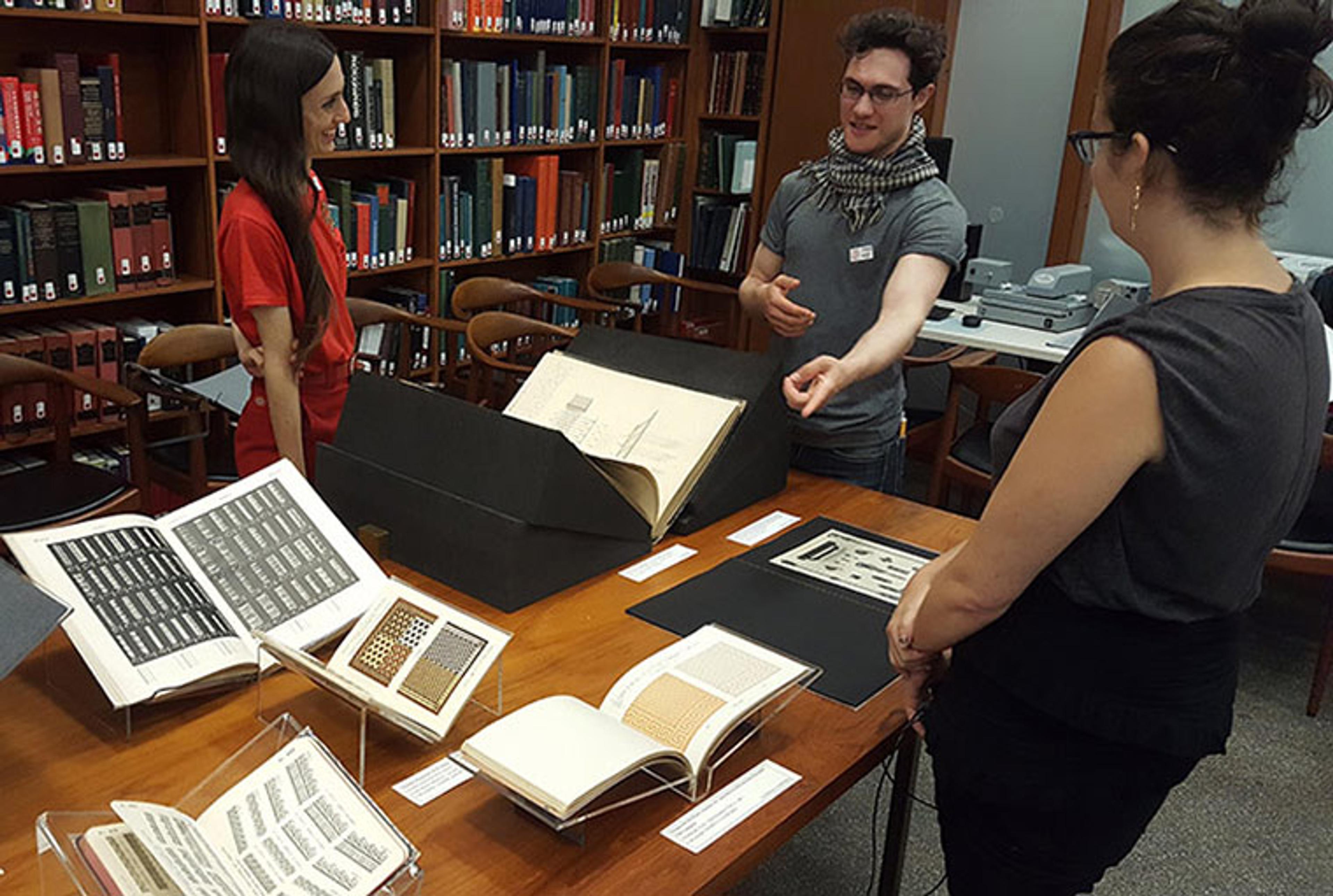
Tauba Auerbach (left) and visitors Daniel Giordano and Sheryl Oppenheim (right) discuss books selected by Auerbach from Watson Library's special collections for "Met Fridays: Artist's Choice."
Tauba has credited Watson Library in playing a pivotal role in her creation of the publication, giving us the following extraordinary endorsement to use in a blog post, reflecting on her experience at the event: "I had such a beautiful experience at Watson. I wish I could embed myself there full-time. Librarians are kind of like neuroscientists—they are the experts on the way the "brain" of the library is organized and interconnects. They are also psychics. They can point you to things that you really wanted to see, but had no idea existed."
Jen Mazza is an artist and educator who first visited Watson in 2014 to conduct research related to what ultimately became an artist's book, 10 White Lies & Poem of the End (New York: Jen Mazza, 2015). Since that time, Jen has been bringing her students from Parsons to consult and conduct research using Watson holdings, in addition to drawing upon Watson's collection for other projects.
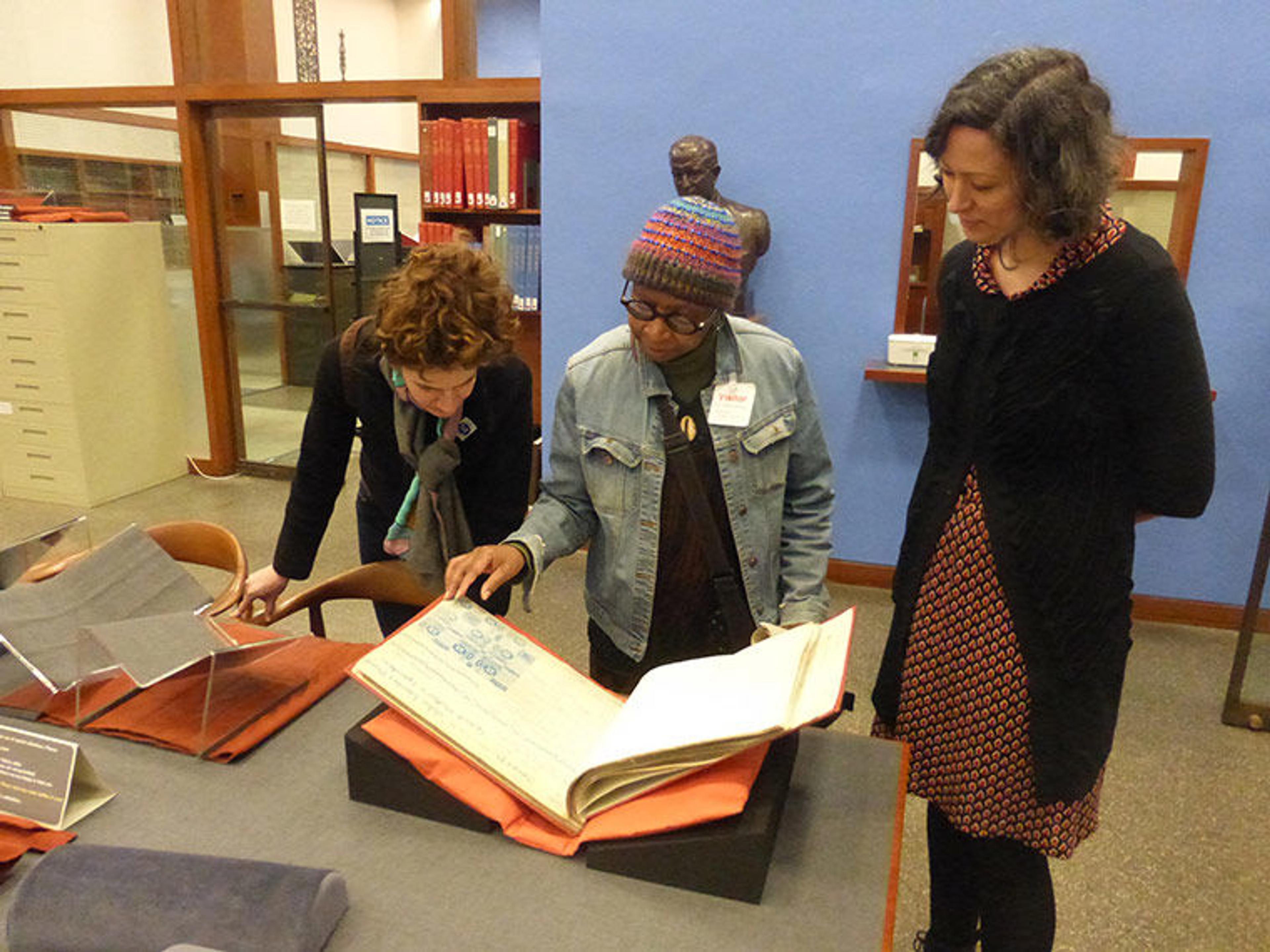
Artists viewing selections from Watson's collection: (left to right) Sarah Jane Lapp, Xenobia Bailey, and Jen Mazza
In a profile of Watson's Special Collections by the website Library as Incubator, Jen offered: "The Watson Library seems an almost infinite resource! […]. The intangible nature of digital research makes more apparent the uniqueness of experience offered by libraries and archives. There is a true vibrancy in the images and materials, which is not to be found online. Being able to touch information, both literally and figuratively, gives something more than just facts and offers an opportunity for contemplation and discovery."

Jen Mazza (standing, center of photo) and students from the Integrative Studio class she teaches at Parsons School of Design, consulting volumes of plates for Denis Diderot and Jean le Rond d'Alembert's Encyclopédie, ou Dictionnaire raisonné des sciences, des arts et des métiers (Paris: Briasson, 1751-1765)
Jen's latest work, exhibited recently at Tibor de Nagy Gallery in New York, includes six oil paintings of bronze Etruscan mirrors that focus on the gaze, inspired by her recollection of an example in The Met's collection on which had been etched the phrase "for the tomb." Intrigued by the defacement interested in additional examples and deeper explanation, Jen turned to Watson Library where she discovered the "very large, unwieldy and many-volumed Corpus Speculorum Etruscorum." CSE enamored Jen in and of itself for its spirit of international cooperation, scale, scope, and ambition of publishing all known existing Etruscan bronze mirrors.
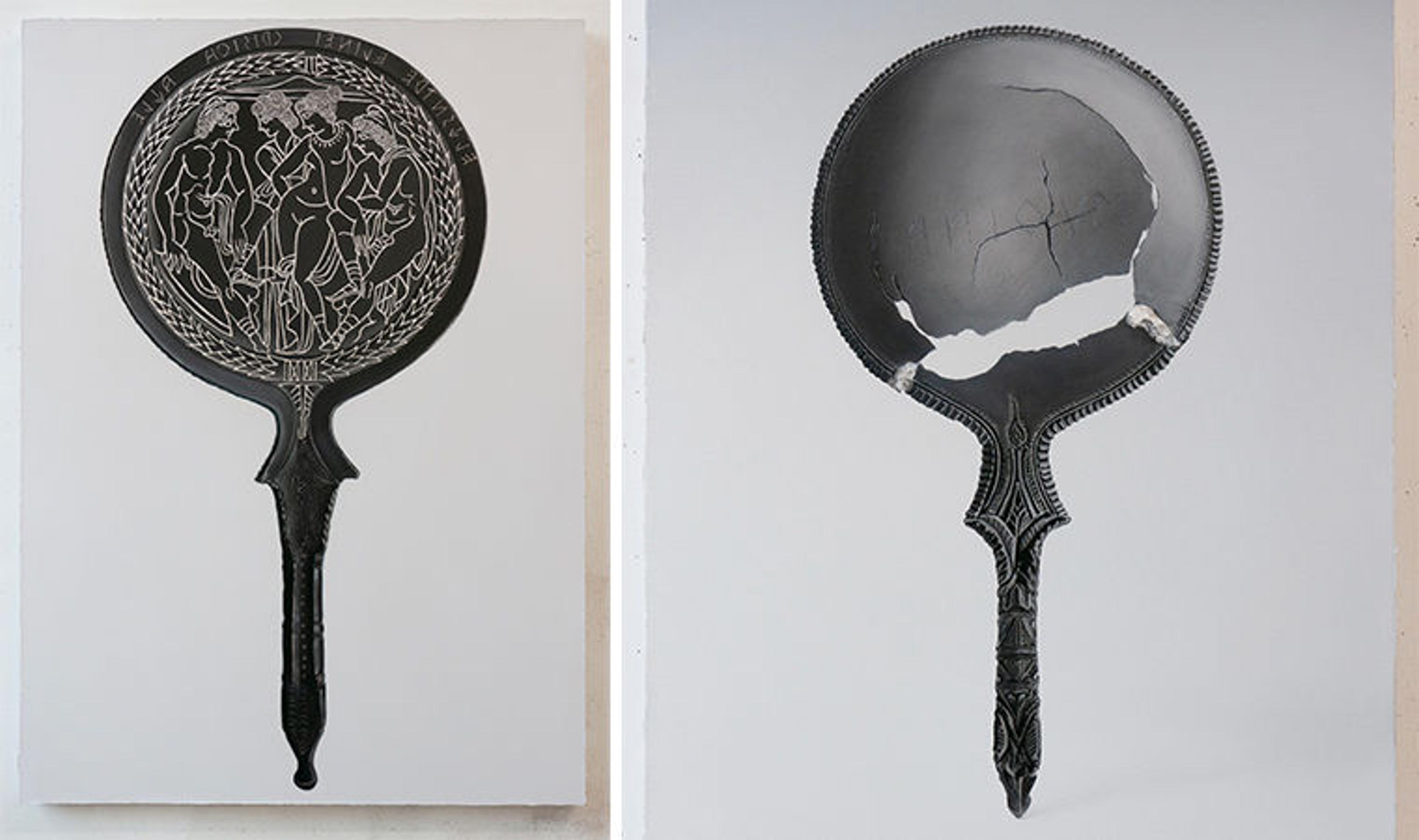
Jen Mazza. The Notion of Us (2), 2020 [right], and The Notion of Us (4), 2019 Oil on canvas. Photos by Jen Mazza
Vien Le Wood is a textile artist, designer, and founder of Gold Spink Studio, a fashion embellishment concept house based in Brooklyn. In 2017, while an artist-in-residence at the Textile Arts Center (TAC), Vien visited Watson with TAC to view works related to textiles, patterns, ornament, and design. Vien took particular interest in a bound collection of geometric, colonial coverlet patterns published by Mary Meigs Atwater in Montana in 1917. (The library acquired these patterns soon after they were published, to meet the high demand for quality weaving patterns). During her residency, Vien produced a series of designs on human hair inspired by the patterns, which she incorporated into a fiber art performance piece.
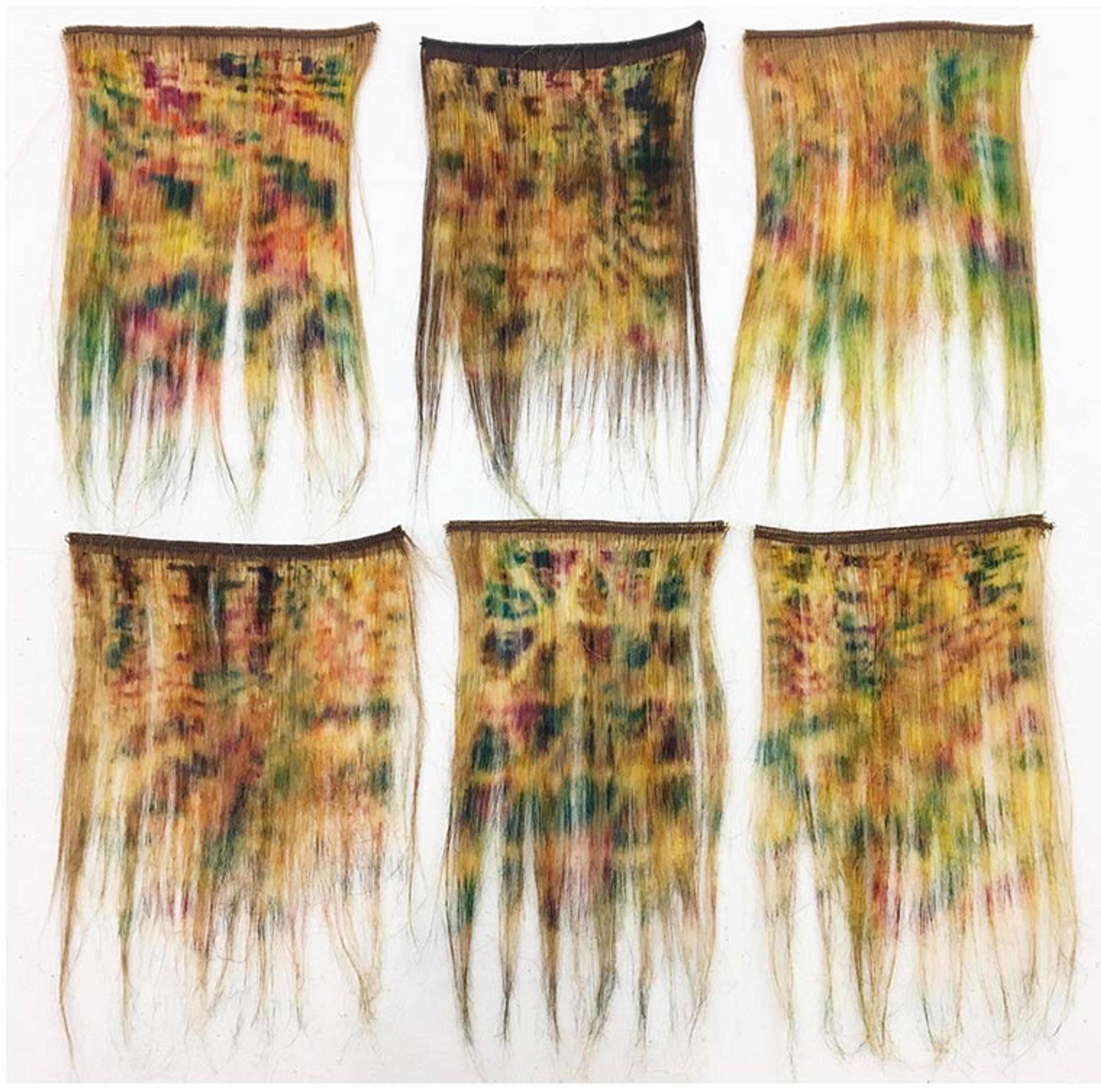
Vien Le Wood. Screenprinted and dyed designs on human hair, inspired by colonial coverlet patterns in Watson's collection. Photo by Vien Le Wood
More recently, Vien has been consulting Watson's holdings of pattern books, textile, and wallpaper sample books from the 1920s and 1930s. In an email, Vien wrote: "The Watson Library has been an eye opening and inspiring space to discover rare artwork that I would never have had access to otherwise. […]. It has been an absolute joy visiting the library and discovering all these gems waiting for me."
Another artist with whom Watson has developed a close connection is Sheryl Oppenheim, whose work is well-represented in Watson's collection. Sheryl is a frequent attendee of Watson events and programs and has drawn extensively upon Watson's holdings for technical research related to paper marbling.
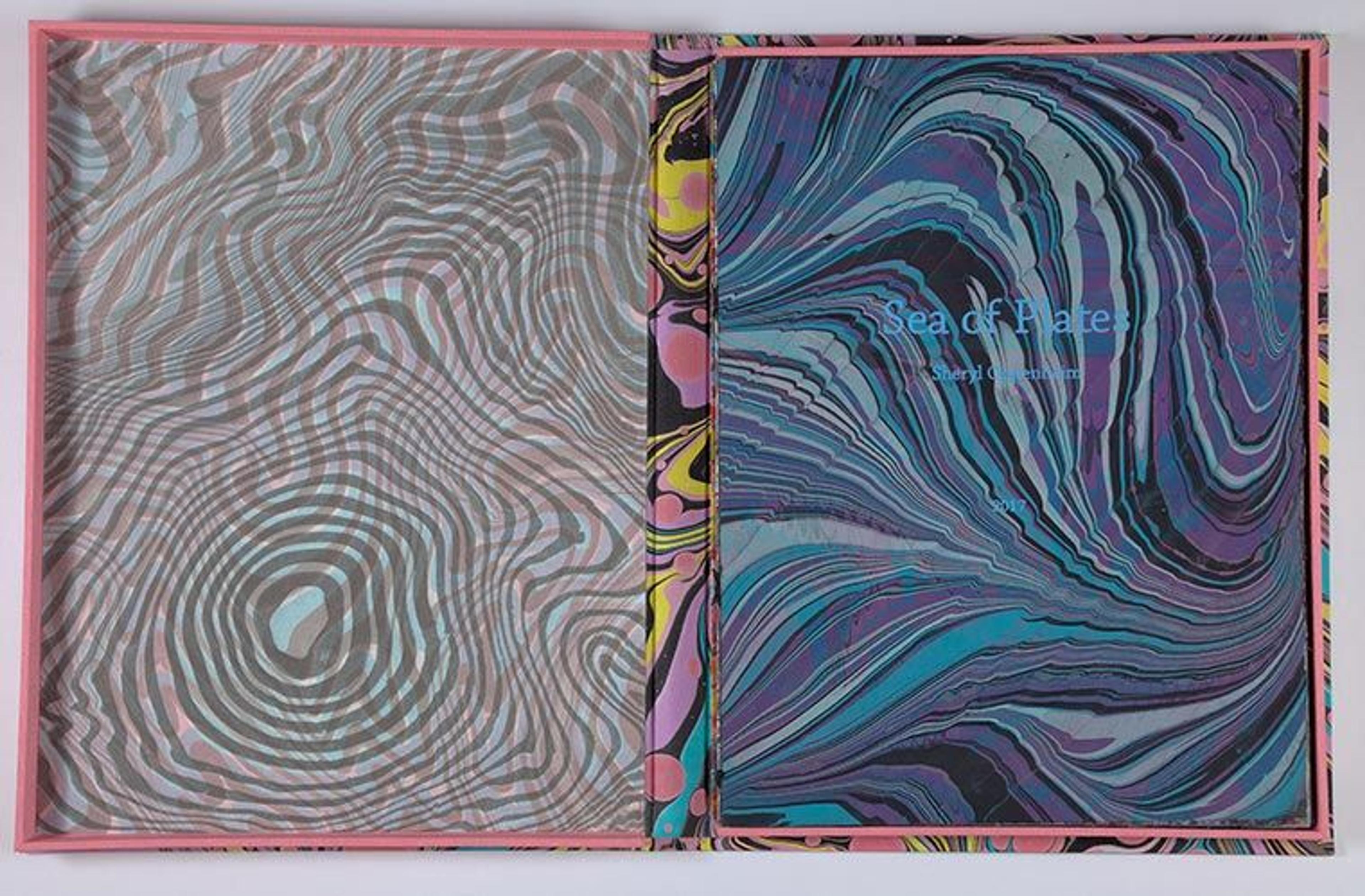
Sheryl Oppenheim, Sea of Plates ([New York]: Small Editions, 2017)
The colophon statements in two of Sheryl's books thoughtfully acknowledge Watson Library "for helping in my research." In an email, Sheryl shared that she had found particularly valuable her consultation of Suminagashi-zome, by Tokutaro Yagi, a book in Watson's collection in which she discovered a recipe for soapberry bark extract, which Yagi used as the white/negative space in his marbling. Sheryl wrote: "My previous internet research had only led me to the chemical Photo-flow, which is environmentally hazardous and much too strong to use for Suminagashi. Doing research at the Met Library has shown me that the internet has much less information than I previously assumed, and that there is so much human knowledge that has not yet left the pages of books."
Are you an artist who uses, or has used Watson Library or another Met departmental library in the past? Has the experience inspired or informed your work in some way? Let us know in the comments below!
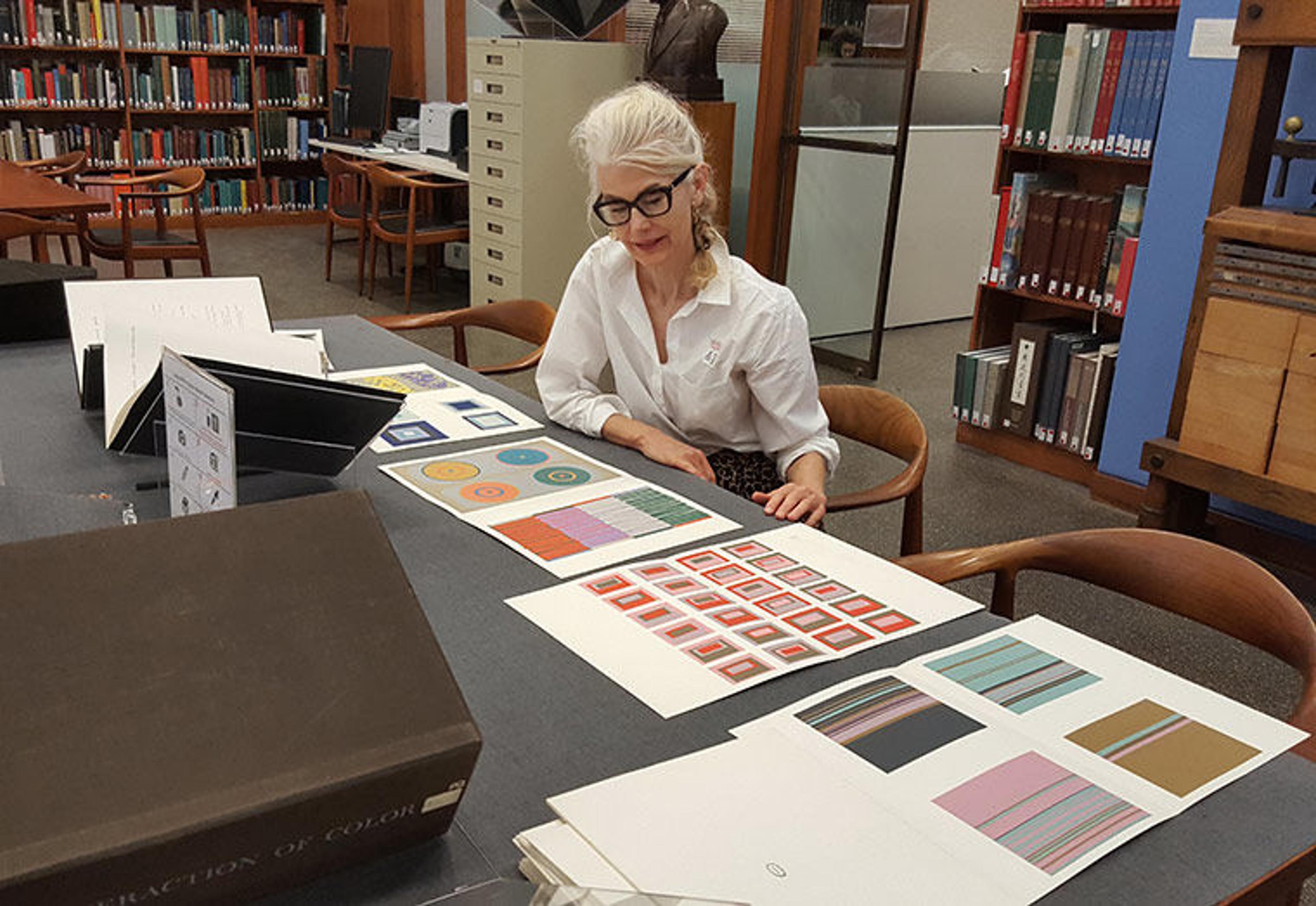
Artist Leah Durner, viewing Josef Albers, Interaction of Color (New Haven: Yale University Press, 1963). Durner has worked in Watson on many projects, including background research for the forthcoming book Painting, Largesse and Life: A Conversation with Leah Durner, which looks at practices and histories of painting, and Durner's work in the context of her involvement with phenomenology.
If you have not conducted research at Watson yet, but would like to, click here for info about using Watson and a link to register online. New readers are welcome and encouraged!
For more in this series on the history of The Met's libraries, click here.
